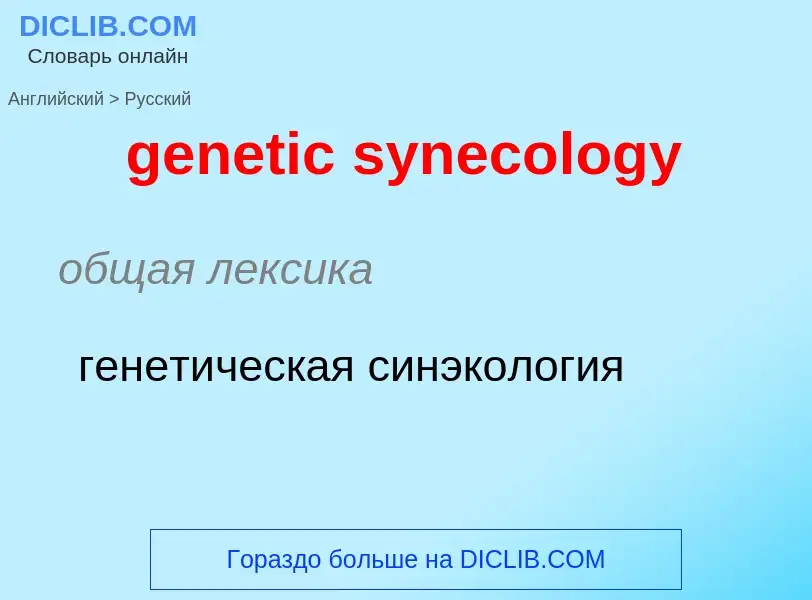Translation and analysis of words by ChatGPT artificial intelligence
On this page you can get a detailed analysis of a word or phrase, produced by the best artificial intelligence technology to date:
- how the word is used
- frequency of use
- it is used more often in oral or written speech
- word translation options
- usage examples (several phrases with translation)
- etymology
genetic synecology - translation to russian
общая лексика
генетическая синэкология
общая лексика
прикладная генетика
Definition
Wikipedia
Genetics is the study of genes, genetic variation, and heredity in organisms. It is an important branch in biology because heredity is vital to organisms' evolution. Gregor Mendel, a Moravian Augustinian friar working in the 19th century in Brno, was the first to study genetics scientifically. Mendel studied "trait inheritance", patterns in the way traits are handed down from parents to offspring over time. He observed that organisms (pea plants) inherit traits by way of discrete "units of inheritance". This term, still used today, is a somewhat ambiguous definition of what is referred to as a gene.
Trait inheritance and molecular inheritance mechanisms of genes are still primary principles of genetics in the 21st century, but modern genetics has expanded to study the function and behavior of genes. Gene structure and function, variation, and distribution are studied within the context of the cell, the organism (e.g. dominance), and within the context of a population. Genetics has given rise to a number of subfields, including molecular genetics, epigenetics and population genetics. Organisms studied within the broad field span the domains of life (archaea, bacteria, and eukarya).
Genetic processes work in combination with an organism's environment and experiences to influence development and behavior, often referred to as nature versus nurture. The intracellular or extracellular environment of a living cell or organism may increase or decrease gene transcription. A classic example is two seeds of genetically identical corn, one placed in a temperate climate and one in an arid climate (lacking sufficient waterfall or rain). While the average height of the two corn stalks may be genetically determined to be equal, the one in the arid climate only grows to half the height of the one in the temperate climate due to lack of water and nutrients in its environment.

![biological inheritance]]. Each strand of DNA is a chain of [[nucleotide]]s, matching each other in the center to form what look like rungs on a twisted ladder. biological inheritance]]. Each strand of DNA is a chain of [[nucleotide]]s, matching each other in the center to form what look like rungs on a twisted ladder.](https://commons.wikimedia.org/wiki/Special:FilePath/DNA Overview2.png?width=200)

![The [[common fruit fly]] (''Drosophila melanogaster'') is a popular [[model organism]] in genetics research. The [[common fruit fly]] (''Drosophila melanogaster'') is a popular [[model organism]] in genetics research.](https://commons.wikimedia.org/wiki/Special:FilePath/Drosophila melanogaster - side (aka).jpg?width=200)
![cellular cloning]]. A similar methodology is often used in [[molecular cloning]]. cellular cloning]]. A similar methodology is often used in [[molecular cloning]].](https://commons.wikimedia.org/wiki/Special:FilePath/Ecoli colonies.png?width=200)
![Human height is a trait with complex genetic causes. [[Francis Galton]]'s data from 1889 shows the relationship between offspring height as a function of mean parent height. Human height is a trait with complex genetic causes. [[Francis Galton]]'s data from 1889 shows the relationship between offspring height as a function of mean parent height.](https://commons.wikimedia.org/wiki/Special:FilePath/Galton-height-regress.png?width=200)


![[[Thomas Hunt Morgan]]'s 1916 illustration of a double crossover between chromosomes [[Thomas Hunt Morgan]]'s 1916 illustration of a double crossover between chromosomes](https://commons.wikimedia.org/wiki/Special:FilePath/Morgan crossover 2 cropped.png?width=200)
![Siamese cats]] have a temperature-sensitive pigment-production mutation. Siamese cats]] have a temperature-sensitive pigment-production mutation.](https://commons.wikimedia.org/wiki/Special:FilePath/Niobe050905-Siamese Cat.jpeg?width=200)
![sex-linked inheritance]] of a mutation causing white eyes in ''[[Drosophila]]'' led him to the hypothesis that genes are located upon chromosomes. sex-linked inheritance]] of a mutation causing white eyes in ''[[Drosophila]]'' led him to the hypothesis that genes are located upon chromosomes.](https://commons.wikimedia.org/wiki/Special:FilePath/Sexlinked inheritance white.jpg?width=200)
![[[Walther Flemming]]'s 1882 diagram of eukaryotic cell division. Chromosomes are copied, condensed, and organized. Then, as the cell divides, chromosome copies separate into the daughter cells. [[Walther Flemming]]'s 1882 diagram of eukaryotic cell division. Chromosomes are copied, condensed, and organized. Then, as the cell divides, chromosome copies separate into the daughter cells.](https://commons.wikimedia.org/wiki/Special:FilePath/Zellsubstanz-Kern-Kerntheilung.jpg?width=200)


![''[[A. tumefaciens]]'' attaching itself to a carrot cell ''[[A. tumefaciens]]'' attaching itself to a carrot cell](https://commons.wikimedia.org/wiki/Special:FilePath/Agrobacterium-tumefaciens.png?width=200)

![Human cells in which some proteins are fused with [[green fluorescent protein]] to allow them to be visualised Human cells in which some proteins are fused with [[green fluorescent protein]] to allow them to be visualised](https://commons.wikimedia.org/wiki/Special:FilePath/Expression of Human Wild-Type and P239S Mutant Palladin.png?width=200)
![A gene gun uses [[biolistics]] to insert DNA into plant tissue. A gene gun uses [[biolistics]] to insert DNA into plant tissue.](https://commons.wikimedia.org/wiki/Special:FilePath/Genegun.jpg?width=200)
![In 1974 [[Rudolf Jaenisch]] created a [[genetically modified mouse]], the first GM animal. In 1974 [[Rudolf Jaenisch]] created a [[genetically modified mouse]], the first GM animal.](https://commons.wikimedia.org/wiki/Special:FilePath/Jaenisch 2003 by Sam Ogden.jpg?width=200)
![[[Polymerase chain reaction]] is a powerful tool used in [[molecular cloning]]. [[Polymerase chain reaction]] is a powerful tool used in [[molecular cloning]].](https://commons.wikimedia.org/wiki/Special:FilePath/Master Mix with Primers form PCR.jpg?width=200)
![Knockout mice]] Knockout mice]]](https://commons.wikimedia.org/wiki/Special:FilePath/PCWmice1.jpg?width=200)
